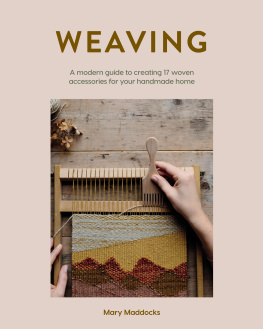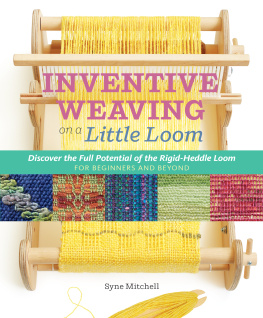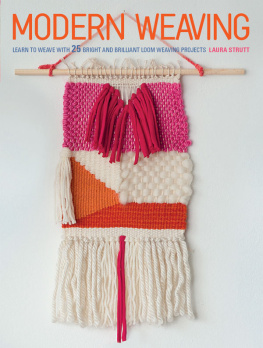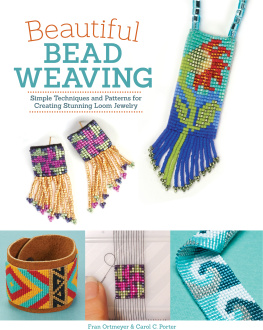


Published by
Princeton Architectural Press
A McEvoy Group company
202 Warren Street
Hudson, New York 12534
www.papress.com
2018 Quarto Publishing plc
an imprint of The Quarto Group
All rights reserved
ISBN: 978-1-61689-712-3 (paperback)
ISBN: 978-1-61689-779-6 (epub, mobi)
No part of this book may be used or reproduced in any manner without written permission from the publisher, except in the context of reviews. Every reasonable attempt has been made to identify owners of copyright. Errors in omissions will be corrected in subsequent editions.
Conceived, edited, and designed by
Quarto Publishing plc
an imprint of The Quarto Group
6 Blundell Street
London N7 9BH
www.quartoknows.com
QUAR.LOOM
Text and pattern/project designs: Fiona Daly
Editor: Kate Burkett
Senior art editor: Jackie Palmer
Designer: Grand Union Design
Photographers: Nicki Dowey, Phil Wilkins, and Mary Daly
Illustrator: Kuo Kang Chen
Art director: Caroline Guest
Creative director: Moira Clinch
Publisher: Samantha Warrington
Library of Congress Cataloging-in-Publication Data is available from the publisher upon request.

CONTENTS

MEET FIONA

Hello! My name is Fiona Daly and Im a textile designer-maker, and weaver. Currently based in a humble studio in South London, I specialize in creating a range of soft furnishings and accessories made with natural British wools in my bespoke woven designs. I sell my work through contemporary craft fairs and my online shop, selling a variety of productsfrom cushions to throws to lampshades and shawls. I also run a program of weaving workshops on frame and table looms from my studio and at various pop-up locations.

My love of constructed textiles began at an early age, influenced by my grandmother, who worked as a lacemaker and ran her own craft shop in the West of Ireland. It was a natural progression that I went on to study Textile Design at the National College of Art and Design, Ireland. During these highly creative stimulating years, I also had the opportunity to study in Bergen, Norway, where my appreciation of traditional crafts and natural materials grew. After graduating, I honed my weaving skills while working for a handweaver in the West of Ireland.
Since then, my weaving journey has evolved many strands. Through being awarded a residency in a weaving center in the Shetland Islands, I greatly developed my woven design skills and I was introduced to the most amazing material, Shetland wool. During my years in Edinburgh, I was involved in a multi-disciplinary craft workshop, where I began teaching weaving courses and fell in love with it! It was also here that I had the wholly enriching experience of working in the weaving workshop of a Rudolf Steiner-inspired organization. During this time I came to acquire the most beautiful weaving looma George Wood dobby loom, a traditional, manual loom with highly complex capabilities where the pattern can be manually programmed by hammering tiny wooden pegs into holes on lags and chains. This has allowed me to push my design skills further and stretch my technical knowledge of weave. Throughout all of this, my love of natural materials, in particular of wool and of particular sheep breeds, continues to grow, along with my interest in sustainable, environmentally friendly textiles.

While weaving can be inherently complex and technical, it provides a fantastic framework for creative expression. One of the reasons I love weaving so much is that it engages both the left and the right sides of the brain. As weaving has developed over thousands of years, one could spend a lifetime studying it and still there would be more to learn. Yet, it can be paired back to a basic principle. Weaving is not a process to be mastered overnight; it requires a lot of patience and practice to understand its magnificent capabilities. The world of weaving is so diverse and complex, with such a variety of looms available, and with such an array of large, expensive equipment, it would be easy to be put off this craft. However, with its origins as a primitive craft, I have realized that it is possible to create beautiful, distinguished weaving with only the most basic of equipment and the most sparse of toolkits. This book aims to guide the novice weaver embarking on this exciting craft!
In this book, you will be introduced to the basics of frame loom weavingthe simplest of weaving looms and therefore, the perfect one to begin weaving withthrough a series of technique tutorials, together with complete project guides. Do not be discouraged if, at first, your weaving is loose with gaping holes, lacks uniform edges, is squint, or if little skips appear in the pattern. Learn to love these imperfections that represent your weaving journey, and know that their decrease maps your progression as a budding weaver. It takes time to master the tension and beat of woven threads and experience to fully appreciate the handle of your chosen material. Relish in the knowledge that you are continuing a traditional craft that has been in continuous practice for almost 10,000 years and is intrinsic to the heritage of cultures the world over.
You will become a master of your own patience and notice how the process of weaving calms and slows things right down. You will tune everything else out and solely concentrate on counting numbers, over and under, while feeling the most beautiful of natural materials feed through your hands. Weaving by hand can be labor intensive and slowa true slow textilebut the rewards are unrivaled. Not only will you come away with a handcrafted woven product, but you will have the satisfaction of the enjoyment gained from the time spent in the making processit is quite the rewarding accomplishment!

CHAPTER 1
WELCOME TO WEAVING

THE HISTORY OF WEAVING

Weaving is a form of constructed textile. Most people are familiar with knitting, which consists of knotted loops made of one continuous strand and worked on two needles. The structure of weaving is different: weaving consists of two sets of interlacing components that are perpendicular to each other. In the weaving of textiles, these components are called threads.
Next page














